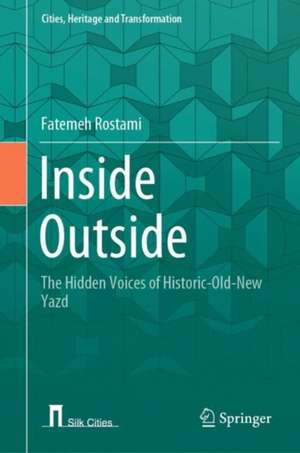Inside Outside: The Hidden Voices of Historic-Old-New Yazd: Cities, Heritage and Transformation
Autor Fatemeh Rostamien Limba Engleză Hardback – 21 iun 2024
Using the "shoe" as a symbol of various social fabrics of Yazd, the book reveals unseen important matters affecting city life from the moment residents put on their shoes to engage within the city and their public lives to the time they remove their shoes on entering their households to share in their private lives. Beyond hearing the locals' voices, the book also examines to what extent scholars’ definitions of place are in parallel or in contrast with the ordinary people’s definitions of their living places.
The book aims to introduce a new urban methodology to urban studies so that local voices can truly be considered in urban planning and design projects. This approach is particularly absent in Iranian urban studies on which this book attempts to investigate, which was examined in Yazd.
Preț: 738.20 lei
Preț vechi: 900.25 lei
-18% Nou
Puncte Express: 1107
Preț estimativ în valută:
141.26€ • 151.05$ • 117.78£
141.26€ • 151.05$ • 117.78£
Carte disponibilă
Livrare economică 27 martie-10 aprilie
Preluare comenzi: 021 569.72.76
Specificații
ISBN-13: 9783031522000
ISBN-10: 3031522001
Ilustrații: XXIV, 343 p. 185 illus., 87 illus. in color.
Dimensiuni: 155 x 235 mm
Greutate: 0.75 kg
Ediția:2024
Editura: Springer Nature Switzerland
Colecția Springer
Seria Cities, Heritage and Transformation
Locul publicării:Cham, Switzerland
ISBN-10: 3031522001
Ilustrații: XXIV, 343 p. 185 illus., 87 illus. in color.
Dimensiuni: 155 x 235 mm
Greutate: 0.75 kg
Ediția:2024
Editura: Springer Nature Switzerland
Colecția Springer
Seria Cities, Heritage and Transformation
Locul publicării:Cham, Switzerland
Cuprins
Chapter 1: Introduction.- Chapter 2: The Notion of Place.- Chapter 3: A short History of Urban Development in Iran and Yazd.- Chapter 4: A Historic Neighbourhood- Fahadan.- Chapter 5: An Old Neighbourhood- Nersi-Abad.- Chapter 6: New Neighbourhood- Safaieh.- Chapter 7: Critical compression of the findings.- Chapter 8: Conclusion.
Textul de pe ultima copertă
This book is the voice of everyday people talking about their city’s poetry–prose transformation. Through the narrative-imagination of the local lives, the book takes the reader on a journey of the past–present–future of Yazd: how the city was formed and transferred from the historic core to the newer parts over time; how people daily engage with the city; why some people enjoy living in the Historic Yazd while others prefer dwelling in the Old and New cities; why these areas are still occupied with the locals keeping the whole city alive and dynamic; if there is a socio-cultural interrelationship between these areas; and hearing the locals’ wishes about the future of their city.
Using the "shoe" as a symbol of various social fabrics of Yazd, the book reveals unseen important matters affecting city life from the moment residents put on their shoes to engage within the city and their public lives to the time they remove their shoes on entering their households to share in their private lives. Beyond hearing the locals' voices, the book also examines to what extent scholars’ definitions of place are in parallel or in contrast with the ordinary people’s definitions of their living places.
The book aims to introduce a new urban methodology to urban studies so that local voices can truly be considered in urban planning and design projects. This approach is particularly absent in Iranian urban studies on which this book attempts to investigate, which was examined in Yazd.
Caracteristici
Examines Muslim and Zoroastrian neighbourhoods Provides simple everyday language of the society analyzed with professional viewpoints Presents a new urban approach for urban studies, prioritizing local voices in planning and design projects





